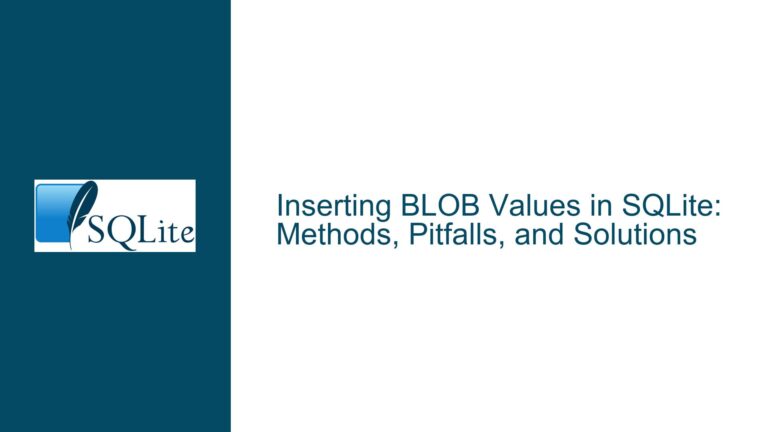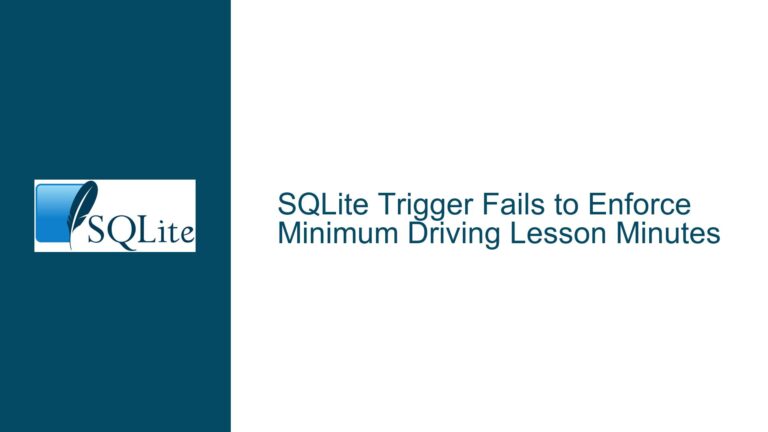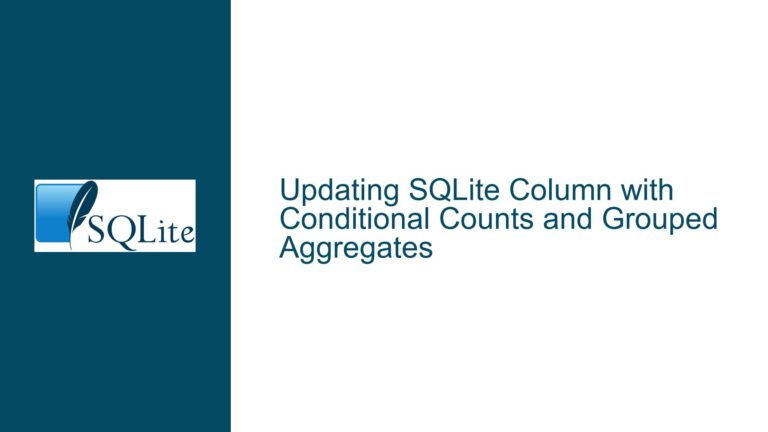Handling Transaction Commit Placement and Error Rollback in SQLite Tcl Interface
Transaction Control Flow and Error Handling in SQLite Tcl Interface
The core challenge revolves around understanding how SQLite’s Tcl interface processes transactions when multiple SQL statements are executed within a single db eval {...} block. Specifically, developers must determine whether placing COMMIT inside the same script as BEGIN ensures atomicity when errors occur. The confusion stems from SQLite’s error propagation behavior within the Tcl interface and the interaction between explicit transaction control commands (BEGIN, COMMIT, ROLLBACK) and Tcl’s error-catching mechanisms.
When a db eval {...} block contains multiple SQL statements, including transaction control commands, SQLite executes them sequentially. If an error occurs in any statement, execution halts immediately, and a Tcl error is raised. This behavior directly impacts whether COMMIT is reached after an error. For example, in a script containing:
db eval {
BEGIN IMMEDIATE;
INSERT INTO test VALUES (4,'D');
INSERT INTO test VALUES (1,'J'); -- Duplicate ID error
INSERT INTO test VALUES (5,'E');
COMMIT;
}
The second INSERT violates the UNIQUE constraint, causing SQLite to abort execution. The COMMIT is never executed, leaving an open transaction. Without explicit error handling, this results in an implicit rollback only if the connection is closed. However, the Tcl interface requires developers to explicitly handle rollbacks via catch or try to avoid lingering transactions that lock the database.
The critical nuance is that SQLite does not automatically roll back transactions when errors occur in mid-transaction. The responsibility falls on the developer to catch errors and execute ROLLBACK. This design allows for error recovery strategies but introduces complexity in ensuring atomicity. The interaction between Tcl’s execution flow and SQLite’s transaction state creates scenarios where improperly handled errors leave transactions open, causing subsequent queries to block or fail due to schema locks.
Risks of Embedded COMMIT and Misinterpreted Error Propagation
1. Premature Transaction Finalization
Placing COMMIT within the same db eval block as BEGIN creates a false assumption that successful execution of all preceding statements is guaranteed. If an error occurs before COMMIT, the transaction remains active, requiring explicit rollback. Developers might erroneously believe the absence of COMMIT automatically reverts changes, but SQLite only rolls back on ROLLBACK, connection closure, or certain fatal errors.
2. Partial Execution in Multi-Statement Eval Blocks
The Tcl db eval command executes SQL statements sequentially until an error occurs. For example:
db eval {
INSERT INTO table1 ...; -- Succeeds
INSERT INTO table2 ...; -- Fails
COMMIT;
}
Here, the first INSERT is committed immediately due to SQLite’s autocommit mode unless wrapped in an explicit transaction. If BEGIN is included, the failure of the second INSERT stops execution, leaving the transaction open. This leads to inconsistent states where developers assume all statements are atomic, but partial changes exist in an uncommitted state.
3. Overreliance on Implicit Rollback Mechanisms
SQLite automatically rolls back transactions if the connection is closed or if a ROLLBACK is triggered by constraint violations in certain configurations. However, relying on this behavior is dangerous in long-lived connections or reusable database handles. For instance, a middleware connection pool might retain an open transaction across multiple requests, causing unintended locking or data corruption.
4. Incongruence Between Tcl Error Handling and SQL Transactions
Tcl’s catch and try commands intercept errors at the script level but do not inherently interact with SQLite’s transaction state. A common anti-pattern is:
if {[catch {
db eval {
BEGIN;
-- SQL statements
COMMIT;
}
} err]} {
puts "Error occurred, but is transaction rolled back?"
}
Even with catch, the transaction remains open unless ROLLBACK is explicitly executed in the error handler. This creates "zombie transactions" that block other writes and violate atomicity guarantees.
Robust Transaction Patterns and Error Recovery Strategies
1. Structured Transaction Handling with Explicit Rollback
Step 1: Isolate Transaction Blocks
Separate transaction control commands from data manipulation logic to avoid ambiguity:
set needs_rollback 0
db eval {BEGIN IMMEDIATE}
try {
db eval {INSERT INTO test VALUES (4,'D')}
db eval {INSERT INTO test VALUES (1,'J')} -- Error here
db eval {INSERT INTO test VALUES (5,'E')}
} on error {err res} {
set needs_rollback 1
puts "Error: $err"
} finally {
if {$needs_rollback} {
db eval {ROLLBACK}
} else {
db eval {COMMIT}
}
}
Advantages:
- Clear separation of transaction boundaries.
- Guaranteed
ROLLBACKon error. - Avoids embedding
COMMITwithin potentially failing operations.
Step 2: Use Savepoints for Nested Operations
When dealing with nested logic, use savepoints for partial rollbacks:
db eval {SAVEPOINT sp1}
try {
db eval {INSERT ...}
db eval {UPDATE ...}
} on error {err res} {
db eval {ROLLBACK TO sp1}
} finally {
db eval {RELEASE sp1}
}
2. Leverage the transaction Method for Atomicity
The SQLite Tcl interface provides a transaction method that automatically wraps operations in a transaction:
db transaction immediate {
db eval {INSERT INTO test VALUES (4,'D')}
db eval {INSERT INTO test VALUES (1,'J')}
db eval {INSERT INTO test VALUES (5,'E')}
}
Key Behaviors:
- Automatically begins a transaction.
- Commits if the block executes successfully.
- Rolls back if any error occurs.
- Propagates errors to the caller for further handling.
Customizing Error Handling:
To retain visibility into transaction outcomes while using transaction:
set committed 0
if {[catch {
db transaction immediate {
-- SQL statements
set committed 1
}
} err]} {
puts "Transaction failed: $err. Rolled back: [expr {!$committed}]"
}
3. Diagnosing Open Transactions and Lock States
Check Transaction Status:
While the Tcl interface lacks direct equivalents to sqlite3_get_autocommit() or sqlite3_txn_state(), you can infer the transaction state:
proc transaction_active {db} {
set autocommit [db one {PRAGMA auto_vacuum}]; # Dummy query
set rc [db eval {BEGIN IMMEDIATE; ROLLBACK}]
return [expr {$rc eq "0"} ? 1 : 0]
}
Explanation:
Attempting BEGIN IMMEDIATE when already in a transaction fails with error code 5 (SQLITE_BUSY). A successful BEGIN followed by immediate ROLLBACK indicates autocommit mode was active.
Monitoring Locks:
Use PRAGMA lock_status (SQLite 3.37+) to diagnose locking issues:
db eval {PRAGMA lock_status} {
puts "$table $state"
}
4. Hybrid Approach: Manual Control with Wrapper Commands
For developers requiring explicit error visibility while avoiding boilerplate code, create transaction wrappers:
proc manual_transaction {db mode script} {
set needs_rollback 1
db eval "BEGIN $mode"
try {
uplevel $script
set needs_rollback 0
} finally {
if {$needs_rollback} {
db eval {ROLLBACK}
} else {
db eval {COMMIT}
}
}
}
# Usage:
manual_transaction db immediate {
db eval {INSERT ...}
db eval {UPDATE ...}
}
Features:
- Enforces
ROLLBACKon error. - Propagates errors to caller.
- Allows custom transaction modes (
DEFERRED,IMMEDIATE,EXCLUSIVE).
5. Testing Error Handling and Transaction Rollbacks
Unit Test Pattern:
proc test_transaction_rollback {} {
sqlite3 db :memory:
db eval {CREATE TABLE test(id INTEGER PRIMARY KEY, val TEXT)}
# Force an error
catch {
manual_transaction db immediate {
db eval {INSERT INTO test VALUES (1,'A')}
db eval {INSERT INTO test VALUES (1,'B')} # Duplicate
}
}
set count [db one {SELECT COUNT(*) FROM test}]
if {$count != 0} {
error "Rollback failed: $count rows present"
}
}
6. Addressing the Original Code Sample
Problematic Code:
if { [catch {
db eval {
begin immediate;
insert into test values (4,'D');
insert into test values (1,'J'); -- Error
insert into test values (5,'E');
commit;
}
} result]} then {
db eval {rollback;}
puts "Rolled back: $result"
}
Flaws:
ROLLBACKis executed after thedb evalblock exits, but the transaction may have already been rolled back automatically.- Redundant
ROLLBACKif SQLite already rolled back due to constraint violation (behavior varies by SQLite version).
Corrected Version:
set rc [catch {
db eval {BEGIN IMMEDIATE}
db eval {INSERT INTO test VALUES (4,'D')}
db eval {INSERT INTO test VALUES (1,'J')}
db eval {INSERT INTO test VALUES (5,'E')}
db eval {COMMIT}
} result]
if {$rc} {
if {[transaction_active db]} {
db eval {ROLLBACK}
}
puts "Error: $result"
}
Final Recommendations:
- Prefer the
transactionmethod for atomic operations unless explicit control is required. - Always pair
BEGINwith explicit error handling that guaranteesROLLBACK. - Validate transaction state after errors using pragmatic checks.
- Avoid multi-statement
db evalblocks for transactions; instead, use separateevalcalls for each SQL command.
By adhering to these patterns, developers ensure robust transaction handling in SQLite’s Tcl interface while maintaining visibility into error conditions and transaction states.






